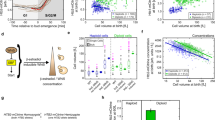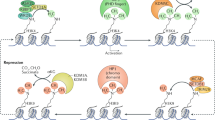Abstract
The H1 class of histones contains several molecular species, even within a single organism 1. The combination of these subtractions varies according to the state of terminal differentiation2,3, embryonic development4 and hormonal induction5. One of the subtractions, H10, occurs at levels that are inversely correlated with the rate of cell division in mammalian tissues6. Although H10 might be functionally or even structurally distinct from the usual H1 histone, Panyim and Chalkley6 established that its size and amino acid composition resembled other H1 histones. The quantitative studies of its relationship to mitotic index were greatly extended by Marks et al.7, and others8–12 have measured H10 contents during processes such as tissue regeneration and selective tissue destruction. All these observations were consistent with the notion that histone H10 suppresses gene replication. One limitation in these demonstrations of the inverse correlation between H10 and cell division is that there are many variable parameters, other than mitotic index, when comparing one tissue to another. This problem is largely overcome by comparing regenerating tissues to their normal counterparts8–11. In the latter situation, it is possible that cell types which always have low H10 contents are preferentially replaced early in the regeneration process, while different cell types with high H10 levels build up in the tissue later. If it could be demonstrated that H10 accumulated along with the arrest of cell division in a single cell type, these ambiguities would be removed. We report here such a demonstration using cultured cells.
This is a preview of subscription content, access via your institution
Access options
Subscribe to this journal
Receive 51 print issues and online access
$199.00 per year
only $3.90 per issue
Buy this article
- Purchase on Springer Link
- Instant access to full article PDF
Prices may be subject to local taxes which are calculated during checkout
Similar content being viewed by others
References
Kinkade, J. M. Jr & Cole, R. D. J. biol. Chem. 241, 5790–5797 (1966).
Bustin, M. & Cole, R. D. J. biol. Chem. 243, 4500–4505 (1968).
Kinkade, J. M. Jr J. biol. Chem. 244, 3375–3386 (1969).
Ruderman, J. V. & Gross, P. R. Devl Biol. 36, 286–298 (1974).
Hohmann, P. & Cole, R. D. J. molec. Biol. 58, 533–540 (1971).
Panyim, S. & Chalkley, R. Biochem. biophys. Res. Commun. 37, 1042–1049 (1969).
Marks, D. B., Kanefsky, T., Keller, B. J. & Marks, A. D. Cancer Res. 35, 886–889 (1975).
Marsh, W. H. & Fitzgerald, P. J. Fedn Proc. 32, 2119–2125 (1973).
Varricchio, F., Mabogunje, O., Kim, D., Fortner, J. G. & Fitzerald, P. J. Cancer Res. 37, 3964–3969 (1977).
Benjamin, W. B. Nature new Biol. 234, 18–20 (1971).
Garrard, W. T. & Bonner, J. J. biol. Chem. 249, 5570–5579 (1974).
Seyedin, S. M. & Kistler, W. S. J. biol. Chem. 254, 11264–11272 (1979).
Medvedev, A. Z., Medvedeva, M. N. & Robson, L. Gerontology 24, 286–292 (1978).
Appels, R. & Wells, J. R. E. J. molec Biol. 70, 425–434 (1972).
Kornberg, R. D. Science 184, 868–871 (1974).
Panyim, S. & Chalkley, R. Archs Biochem. Biophys. 130, 337–346 (1969).
Author information
Authors and Affiliations
Rights and permissions
About this article
Cite this article
Pehrson, J., Cole, R. Histone H10 accumulates in growth-inhibited cultured cells. Nature 285, 43–44 (1980). https://doi.org/10.1038/285043a0
Received:
Accepted:
Issue Date:
DOI: https://doi.org/10.1038/285043a0
This article is cited by
-
Posttranscriptional regulation of H1° and H3.3B histone genes in differentiating rat cortical neurons
Neurochemical Research (1995)
-
H1° and H3.3B mRNA levels in developing rat brain
Neurochemical Research (1994)
-
Qualitative differences in nuclear proteins correlate with neuronal terminal differentiation
Cellular and Molecular Neurobiology (1992)
-
Anti-histone antibodies in subacute sensory neuropathy
Journal of Neuro-Oncology (1991)
-
Effects of antineoplastic phospholipids on parameters of cell differentiation in U937 cells
Journal of Cancer Research and Clinical Oncology (1990)
Comments
By submitting a comment you agree to abide by our Terms and Community Guidelines. If you find something abusive or that does not comply with our terms or guidelines please flag it as inappropriate.



